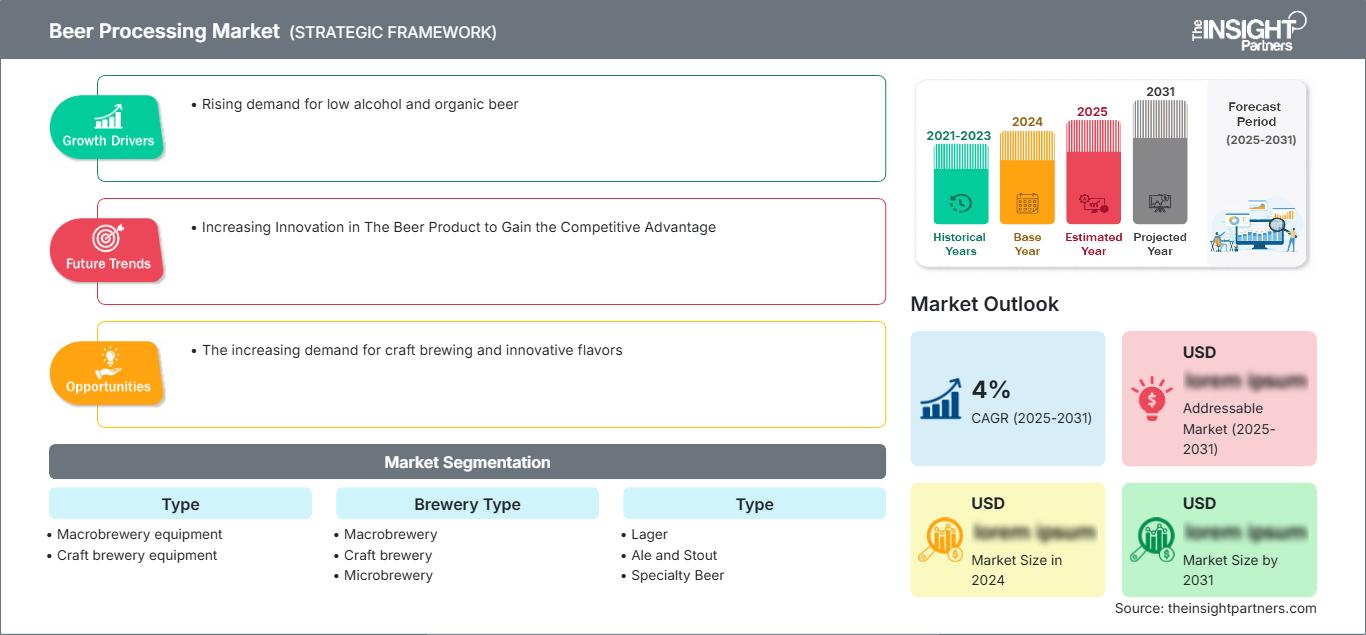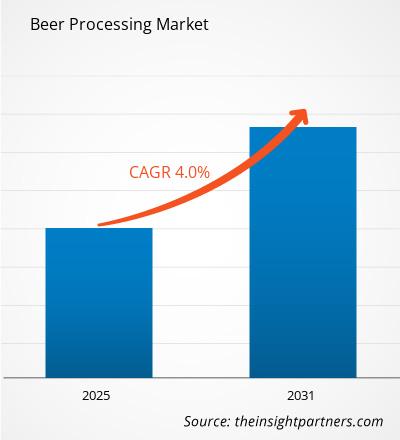Der Markt für Bierverarbeitung wird zwischen 2023 und 2031 voraussichtlich eine durchschnittliche jährliche Wachstumsrate von 4 % verzeichnen. Die steigende Nachfrage nach Craft-Bier und innovativen Geschmacksrichtungen dürfte ein wichtiger Markttrend bleiben.
Marktanalyse Bierverarbeitung:
- Der globale Markt für Bierverarbeitung verzeichnet einen positiven Einfluss auf den steigenden Bierkonsum.
- Darüber hinaus treiben verbesserte Wasseraufbereitungstechniken, die zunehmende Präferenz der Verbraucher für Bier gegenüber anderen alkoholischen Getränken und das steigende verfügbare Einkommen der Verbraucher in Industrie- und Entwicklungsländern den Markt auf ein neues Niveau.
- Zukünftige Faktoren wie die Bevölkerungsexplosion unter jungen Menschen und die zunehmende Kaufbereitschaft weiblicher Trinker werden den Markt voraussichtlich antreiben.
- Darüber hinaus verbessern die steigende Anzahl von Mikrobrauereien, die Konsolidierung von Lokalbrauereien und die Anzahl der Bierbrauereien die Marktaussichten.
- Auf der anderen Seite haben Innovationen bei Brauereianlagen und ein wachsender Trend zu alkoholarmem Bier und Craft Beer bei den Verbrauchern die Wahrnehmung des Konsums von alkoholischen Getränken grundlegend verändert. Getränke.
Marktübersicht Bierverarbeitung
- Aufgrund des deutlichen Wachstums von handwerklich gebrautem Bier und Premium-Bier, einer steigenden Anzahl von Braukneipen und Mikrobrauereien sowie dem Markenaufbau für Brauereimaschinen erlebt die Bierverarbeitungsindustrie mit der Zeit einen Aufschwung.
- Im Gegenteil, hohe Wartungskosten, enorme Kapitalausgaben und steigende Energiekosten werden voraussichtlich die Marktentwicklung verlangsamen und gleichzeitig neue Wege für Hersteller im Bierverarbeitungsmarkt schaffen.
Passen Sie diesen Bericht Ihren Anforderungen an
Sie erhalten kostenlos Anpassungen an jedem Bericht, einschließlich Teilen dieses Berichts oder einer Analyse auf Länderebene, eines Excel-Datenpakets sowie tolle Angebote und Rabatte für Start-ups und Universitäten.
Markt für Bierverarbeitung: Strategische Einblicke

- Holen Sie sich die wichtigsten Markttrends aus diesem Bericht.Dieses KOSTENLOSE Beispiel umfasst Datenanalysen, die von Markttrends bis hin zu Schätzungen und Prognosen reichen.
Sie erhalten kostenlos Anpassungen an jedem Bericht, einschließlich Teilen dieses Berichts oder einer Analyse auf Länderebene, eines Excel-Datenpakets sowie tolle Angebote und Rabatte für Start-ups und Universitäten.
Markt für Bierverarbeitung: Strategische Einblicke

- Holen Sie sich die wichtigsten Markttrends aus diesem Bericht.Dieses KOSTENLOSE Beispiel umfasst Datenanalysen, die von Markttrends bis hin zu Schätzungen und Prognosen reichen.
Treiber und Chancen im Bierverarbeitungsmarkt
Steigende Nachfrage nach alkoholarmem und Bio-Bier
- Die steigende Nachfrage nach alkoholarmem und Bio-Bier hat sich zu einem wichtigen Treiber im Bierverarbeitungsmarkt entwickelt.
- Verbraucher legen zunehmend Wert auf einen gesünderen Lebensstil, was zu einem steigenden Interesse an Bieren mit geringerem Alkoholgehalt und aus Bio-Zutaten führt.
- Dieser Trend veranlasst Brauereien, ihre Produktionsprozesse zu erneuern und anzupassen, um diesen sich wandelnden Vorlieben gerecht zu werden.
- Alkoholarme Biere bieten den Reiz einer reduzierten Kalorienaufnahme und die Möglichkeit, mehr Getränke verantwortungsvoll zu genießen.
- Im Gegensatz dazu richten sich Bio-Biere an umweltbewusste Verbraucher, die Produkte ohne synthetische Pestizide und Düngemittel suchen.
- Aus diesem Grund investieren Bierverarbeiter in neue Technologien und Verfahren, um geschmackvolle, hochwertige Alkohol- und Bio-Optionen, erweitern ihr Produktportfolio und erschließen dieses wachsende Marktsegment.
Steigerung der Innovation im Bierprodukt zur Erlangung eines Wettbewerbsvorteils
- Darüber hinaus kann Innovation bei Bierprodukten eine lukrative Gelegenheit für Unternehmen im Bierverarbeitungsmarkt darstellen, sich einen Wettbewerbsvorteil zu verschaffen.
- Innovationen bei Aromen, Zutaten oder Brautechniken können einer Brauerei einen Wettbewerbsvorteil verschaffen, wenn sie einen einzigartigen Geschmack, neuartige Zutaten oder eine Brautechnik anbietet.
- Obwohl dies verschiedene Formen annehmen kann, kann eine Brauerei, die mit neuen aromatischen Hopfen innovativ ist, ein unverwechselbares Craft-Beer-Angebot kreieren, oder eine Brauerei, die mit alkoholarmem oder alkoholfreiem Brauen innovativ ist, kann ein alkoholfreies Bier auf den Markt bringen, das alkoholarme oder nüchterne, neugierige Trinker anspricht.
- Darüber hinaus kann der Einsatz von Technologie zur Erzielung einer gleichmäßigeren Mälzung, von Braukomponenten oder zur Optimierung der Gärung oder Filtrationsprozesse können zu einer gleichmäßigeren Qualität mit weniger Abweichungen und einem gleichmäßigeren Geschmack führen.
- Diese Optimierung kann aufgrund der höheren Skalierbarkeit zu einem günstigeren Preis führen. So können Brauereien durch Innovationen im Brauprozess einen Wettbewerbsvorteil erzielen. Das Ergebnis ist ein effizienterer und potenziell kostengünstigerer Prozess, bei dem mehr vom ursprünglichen Geschmack im Endprodukt erhalten bleibt.
- Zusätzlich zu diesen Vorteilen ändert sich der Geschmack der Verbraucher, und Brauereien, die innovativ sind und sich an diese Veränderungen anpassen, werden letztendlich Marktanteile und Kundentreue gewinnen und sich so einen Wettbewerbsvorteil in diesem spannenden Biermarkt verschaffen.
Segmentierungsanalyse des Marktberichts zur Bierverarbeitung
Der Umfang des globalen Marktes für Bierverarbeitung ist nach Gerätetyp, Brauereityp, Typ, Preiskategorie und Vertriebskanal segmentiert.
- Basierend auf dem Gerätetyp wird der Markt für Bierverarbeitung in Großbrauereiausrüstung und Handwerksbrauereiausrüstung unterteilt.
- Auf Grundlage des Brauereityps wird der Markt in Großbrauereien, Craft-Brauereien, Mikrobrauereien, Gasthausbrauereien und Sonstiges unterteilt.
- Basierend auf dem Basistyp wird der Markt in Lager, Ale und Stout, Spezialbier, alkoholarmes Bier und Bier segmentiert.
- Auf Grundlage der Preiskategorie wird der Markt in Mainstream, Discount, Premium und Super-Premium kategorisiert.
- Basierend auf dem Vertriebskanal wird der Markt in Off-Trade und On-Trade segmentiert.
Marktanteilsanalyse der Bierverarbeitung nach Geografie
- Der Marktbericht zur Bierverarbeitung umfasst eine detaillierte Analyse von fünf großen geografischen Regionen, einschließlich der aktuellen und historischen Marktgröße und Prognosen für 2021 bis 2031, die Nordamerika, Europa, den asiatisch-pazifischen Raum (APAC), den Nahen Osten und Afrika (MEA) sowie Süd- und Mittelamerika abdecken.
- Jede Region ist weiter in die jeweiligen Länder unterteilt. Dieser Bericht bietet Analysen und Prognosen für über 18 Länder und deckt die Dynamik des Bierverarbeitungsmarktes ab, wie z. B. Treiber, Trends und Chancen, die die Märkte auf regionaler Ebene beeinflussen.
- Der Bericht umfasst außerdem Porters Fünf-Kräfte-Analyse, die die Untersuchung der wichtigsten Faktoren umfasst, die den Bierverarbeitungsmarkt in diesen Regionen beeinflussen.
Bierverarbeitungsmarkt
Die Analysten von The Insight Partners haben die regionalen Trends und Faktoren, die den Bierverarbeitungsmarkt im Prognosezeitraum beeinflussen, ausführlich erläutert. In diesem Abschnitt werden auch die Marktsegmente und die geografische Lage in Nordamerika, Europa, dem asiatisch-pazifischen Raum, dem Nahen Osten und Afrika sowie Süd- und Mittelamerika erörtert.Umfang des Marktberichts zur Bierverarbeitung
| Berichtsattribut | Einzelheiten |
|---|---|
| Marktgröße in 2024 | US$ XX million |
| Marktgröße nach 2031 | US$ XX Million |
| Globale CAGR (2025 - 2031) | 4% |
| Historische Daten | 2021-2023 |
| Prognosezeitraum | 2025-2031 |
| Abgedeckte Segmente |
By Typ
|
| Abgedeckte Regionen und Länder | Nordamerika
|
| Marktführer und wichtige Unternehmensprofile |
|
Dichte der Marktteilnehmer im Bierverarbeitungsmarkt: Verständnis ihrer Auswirkungen auf die Geschäftsdynamik
Der Markt für Bierverarbeitung wächst rasant, angetrieben durch die steigende Endverbrauchernachfrage aufgrund von Faktoren wie sich verändernden Verbraucherpräferenzen, technologischem Fortschritt und einem stärkeren Bewusstsein für die Produktvorteile. Mit steigender Nachfrage erweitern Unternehmen ihr Angebot, entwickeln Innovationen, um den Verbraucherbedürfnissen gerecht zu werden, und nutzen neue Trends, was das Marktwachstum weiter ankurbelt.

- Holen Sie sich die Markt für Bierverarbeitung Übersicht der wichtigsten Akteure
Neuigkeiten und aktuelle Entwicklungen zum Bierverarbeitungsmarkt:
Der Bierverarbeitungsmarkt wird durch die Erhebung qualitativer und quantitativer Daten aus Primär- und Sekundärforschung bewertet, die wichtige Unternehmenspublikationen, Verbandsdaten und Datenbanken umfasst. Im Folgenden finden Sie eine Liste der Entwicklungen auf dem Markt für Innovationen, Geschäftserweiterungen und Strategien:
- Heineken plante, 300 Millionen US-Dollar in Brasilien zu investieren, um sein Premium-Bierportfolio zu erweitern und die Produktionskapazität seiner Marken Amstel, Devassa und Heineken zu steigern. Die Investition ist Teil des Expansionsplans von Heineken, der brasilianische Biertrinker als Hauptkonsumenten anspricht. (Quelle: Heineken, Newsletter, Mai 2023)
- AB InBev hat in Indien eine neue Biermarke namens Seven Rivers auf den Markt gebracht, die sich auf lokal bezogene Zutaten und Aromen konzentriert. Das Produkt wird zunächst in Karnataka und Maharashtra erhältlich sein, gefolgt von Delhi, Goa, Haryana und Uttar Pradesh. Die Marke wird vorerst nur in Indien erhältlich sein. (Quelle: Anheuser Busch Inbev NV, Newsletter, Mai 2022)
Bericht zum Markt für Bierverarbeitung: Umfang und Ergebnisse
Der „Markt für Bierverarbeitung: Größe und Prognose (2021 – 2031)“ bietet eine detaillierte Analyse des Marktes, die die folgenden Bereiche abdeckt:
- Marktgröße und Prognose für die Bierverarbeitung auf globaler, regionaler und Länderebene für alle abgedeckten wichtigen Marktsegmente
- Markttrends und Marktdynamiken wie Treiber, Einschränkungen und wichtige Chancen im Bierverarbeitungsmarkt
- Detaillierte PEST/Porters Five Forces- und SWOT-Analyse
- Marktanalyse für die Bierverarbeitung, die wichtige Markttrends, globale und regionale Rahmenbedingungen, wichtige Akteure, Vorschriften und aktuelle Marktentwicklungen umfasst
- Branchenlandschaft und Wettbewerbsanalyse, die Marktkonzentration, Heatmap-Analyse, prominente Akteure und aktuelle Entwicklungen im Bierverarbeitungsmarkt umfasst
- Detaillierte Unternehmensprofile
- Historische Analyse (2 Jahre), Basisjahr, Prognose (7 Jahre) mit CAGR
- PEST- und SWOT-Analyse
- Marktgröße Wert/Volumen – Global, Regional, Land
- Branchen- und Wettbewerbslandschaft
- Excel-Datensatz
Aktuelle Berichte
Erfahrungsberichte
Grund zum Kauf
- Fundierte Entscheidungsfindung
- Marktdynamik verstehen
- Wettbewerbsanalyse
- Kundeneinblicke
- Marktprognosen
- Risikominimierung
- Strategische Planung
- Investitionsbegründung
- Identifizierung neuer Märkte
- Verbesserung von Marketingstrategien
- Steigerung der Betriebseffizienz
- Anpassung an regulatorische Trends






















 Kostenlose Probe anfordern für - Markt für Bierverarbeitung
Kostenlose Probe anfordern für - Markt für Bierverarbeitung